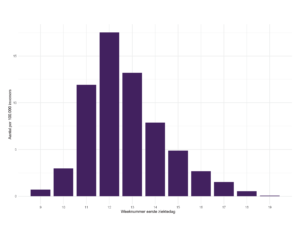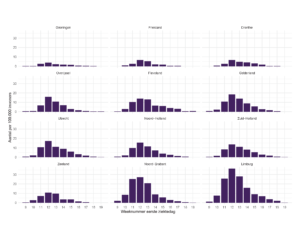In order to, monitor the effect of measures taken against the spread of the new coronavirus, the time when reported COVID-19 patients became ill, was examined. This relates to patients who ultimately had to be hospitalized. The effect of the measures on the number of hospitalisations is only visible at least one week after the start of the measures. That is because, there’s a time lag between infection, the first symptoms of the disease and the hospitalisation.
On Thursday 12 March, the first national measures were announced to combat the COVID-19 pandemic. The measures included, staying at home in case of mild complaints, cancellation of events and working from home as much as possible. Schools, restaurants and sports clubs closed down on 15 March.
The highest number of reported COVID-19 patients fell ill in the week of 16 to 22 March (week 12). Graphs 1 and 2 below show a decrease in the number of reported COVID-19 hospitalizations per 100,000 inhabitants from week 13, both nationwide and in all provinces. This indicates that the national measures have been effective in curbing the COVID-19 epidemic.
The peak of the epidemic fell in all provinces in the same week (week 12). This is striking because there were large differences in the numbers of patients admitted to hospital per province.
Graph 1. (below) Number of reported hospitalized COVID-19 patients per 100,000 inhabitants, in the week of first day of illness.

Graph 2: (below) Number of reported hospitalized COVID-19 patients per 100,000 inhabitants per province, by week of first day of illness

Source: RIVM
Translation: Chaitali Sengupta, who gives ONLINE Inburgering classes.











